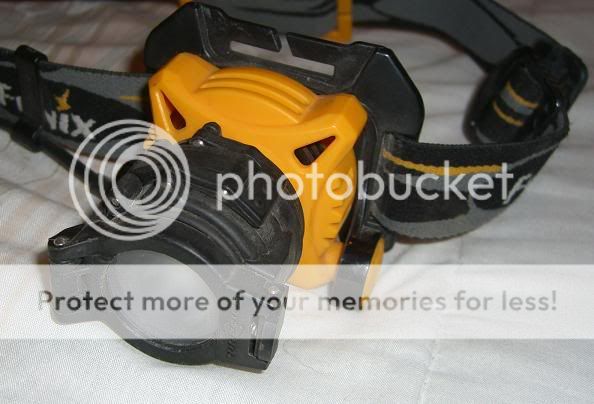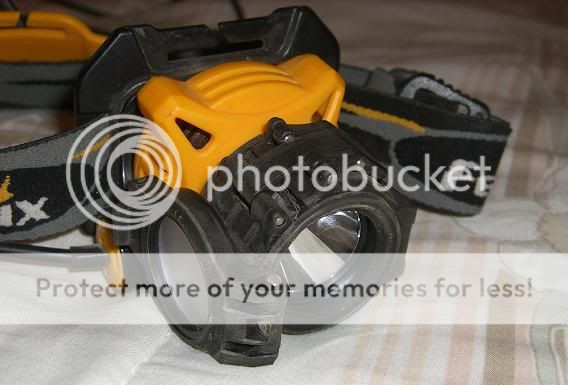DisrupTer911
Enlightened
Def think I'm gonna have to pick this up before my camping trip
 Help Support Candle Power Flashlight Forum
Help Support Candle Power Flashlight Forum
Just bought three more. Got a little price break.. So much for waiting for the s2 bin. I figured, I pay now or if I wait for the xpg U2 bin, in other ways.
Before you alter your top strap, post a photo of it and I'll try to explain what I did. It shouldn't need to be altered, only change the position of the buckles.
Not sure if same as yours, but I reconfigured to make one long strap of elastic with two loops on end, looping each end back onto self. I also added reflective tape to back and sides of battery case since I was missing the Remington rear led, which is good for late night walks with family on the streets.
My three lights came in three days by priority mail, shipped from the NY warehouse. There is a lottery on color. (I hoped Cree has quashed this lottery in last 3 years, but apparently not.) None were horribly cold, but none were as warm as the first, only one close.
This is my first 4 aa regulated light. I have read reviews of the dx regulated lights (none with very good or useful runtimes), so the tail current reading should not have shocked me. I found the lower the voltage/more tired the cells the higher the current draw. This is especially true on the turbo setting, with as high as one amp for the 277 rating. I guess I expected a constant current over runtime, by simply lowering resistance. So tail cap reading will vary by voltage, but my first NiMH off charger were: 8ma, 99 ma, 266 ma, 777 ma. Fresh alkaline, a bit lower, especially on turbo.
That's right - the LED current is what a regulated driver will try to keep constant.Please correct me if I am wrong, but I believe the current that is regulated is the output current (and voltage) which is driving the LED, not the power supply current.


Therrin, not enough info to reproduce your diffuser.
I am still trying to get a handle on the best brand of batteries to use in this light. For my use, I require 8 to 10 hours of 133 lumen out put on one set of cells. So eneloop amateurs don't meet my specs. What I am finding though that since the regulator ups the current as voltage drops, I am not getting anything near the specified runtime (about 6.25 hours on sanyo 2700s with four cycles at the 133 lumen output), and packs are going out of regulation at 1.2 volts per cell with older cells crapping out around 2.8 hours at 133 lumens.
I cannot complain since when the hp11 looses the 133 level, it just goes to the 50 lumen level for next xx hours. Fortunately, the unit throws great and has great out the front efficiency, so at the 50 lumen level rivals many lights at 80 to 100 lumens, and a worker still has plenty of light on the battery sipping medium for next few hours for extreme detail work up to 6 foot away.
I am wondering if I am not breaking in my 2700s properly by just hitting condition on the maha c204w. The hp11 target runtimes are perfect, and even when falling short (I prefer the 133 lumen level for 8 to 10 hours) the unit is still bright at the 50 lumen level. So, I can't complain. My eneloop xx batteries are in the mail. I am also pondering value of the Tenergy 2600s (worried they will be as crappy as kodak or the energizer 2500s and 2450s.) the accuevolution 2200 lsds. If none of the battery brands meet my specs, I may just go 1500 cycle eneloops and demand a 5 hour battery swap and buy more charging bays--which will cost over time and frustration.
Not sure if it was mentioned already in this thread or if it was in another Fenix light thread, but before you go any further quoting Fenix's stated runtimes, be aware that these are ANSI standard runtimes. This means that the quoted runtime goes on until the light output drops to 10% YES 10% of the starting output. If Fenix state 6hrs at the 133lm output level, this means that at 6hrs, the output will be 13.3lm, not 133lm.
There is currently no standard that indicates the runtime at any particular regulated output level.
You need to understand this clearly as you will never achieve runtimes that maintain the listed output level for the entire time stated.
Fortunately, Fenix here has a much better correlation to stated runtime and actual than just some vague 10%: I am probably will be getting-once batteries are broken in- close to 7 hours of 133 lumens before it only puts out 50 lumens. Why wouldn't they just spec something like, 7 hours (with 2500's) regulated to 133 lumens then 3 hours unregulated?